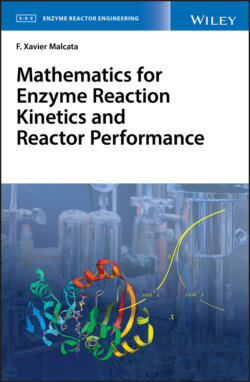Читать книгу Mathematics for Enzyme Reaction Kinetics and Reactor Performance - F. Xavier Malcata - Страница 40
3.2 Multiplication of Scalar by Vector
ОглавлениеAnother common operation is multiplication of vector u by scalar α; this produces a new vector αu, collinear with u but with opposite direction if α < 0 – with length given by |α|‖ u ‖, as apparent in Fig. 3.1b. Using vector coordinates, one accordingly finds that
– so the coordinates in each direction of space are expanded (or contracted) proportionally. Based on Eq. (3.30), one may equivalently write
due to the commutativity of the product of scalars, Eq. (3.31) yields
(3.32)
One therefore concludes that
following comparative inspection of Eqs. (3.30) and (3.33) – so multiplication of scalar by vector is commutative.
Denoting a second scalar by β, it can be stated that
(3.34)
with the aid of Eq. (3.30); a second application of the algorithm conveyed by Eq. (3.30) unfolds
(3.35)
– where the associative property of multiplication of scalars supports
Equation (3.36) may be rewritten as
(3.37)
at the expense of Eq. (3.30), which condenses to
with the aid of Eq. (3.1); this means that multiplication of scalar by vector is associative.
One finally realizes that
(3.39)
in view of Eq. (3.19), which becomes
(3.40)
as per Eq. (3.30); the distributive property of multiplication of scalars has it that
(3.41)
where Eq. (3.19) taken backward supports conversion to
Equation (3.22) finally permits transformation of Eq. (3.42) to
(3.43)
which prompts
(3.44)
once Eqs. (3.1) and (3.2) are recalled; hence, multiplication of scalar by vector is distributive with regard to addition of vectors.
On the other hand, Eq. (3.1) entails
(3.45)
which is equivalent to
(3.46)
due to Eq. (3.30); the distributive property of multiplication of scalars may again be invoked to write
(3.47)
whereas Eq. (3.19) justifies transformation to
Recalling Eq. (3.22), it is possible to convert Eq. (3.48) to
(3.49)
which can be combined with Eq. (3.30) to yield
(3.50)
Eq. (3.1) finally permits condensation to
thus proving that multiplication of scalar by vector is distributive also with regard to addition of scalars.
